How do I clean my iron?
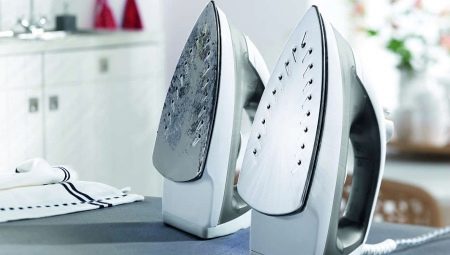
Each of us uses the iron almost every day. When ironing every day, we do not even think about the dangers that lie in wait for this household appliance. Simple inattention can lead to external or internal pollution, which can confuse an inexperienced housewife. If you do not make proper cleaning, then the iron will have to be thrown away. It is important to know the most effective ways to clean the appliance.

The reasons for the blockage
A dirty iron can become a serious obstacle on the way to ironed items. Steam stops escaping, scale appears, stains remain on things after ironing - just an incomplete list of what happens as a result of the appearance of dirt.
Reasons for contamination of the iron:
- Unfiltered tap water causes limescale to build up inside the iron. This prevents the steaming or moisturizing function of the fabric from being fully utilized.
- Yellow streaks appear on your clothes if salts have started to build up on the heating element.
- Too high a temperature during ironing leads to the formation of carbon deposits on the soleplate. It, in turn, is transferred to clothing.
- Long-term contact of the hot iron with synthetic fibers.
- If substances with resin or glue get on the hot sole, the sole will become dirty.
Using a dirty iron for its intended purpose is dangerous for both clothing and electrical appliances. If you notice a problem, turn off the iron and start taking action.
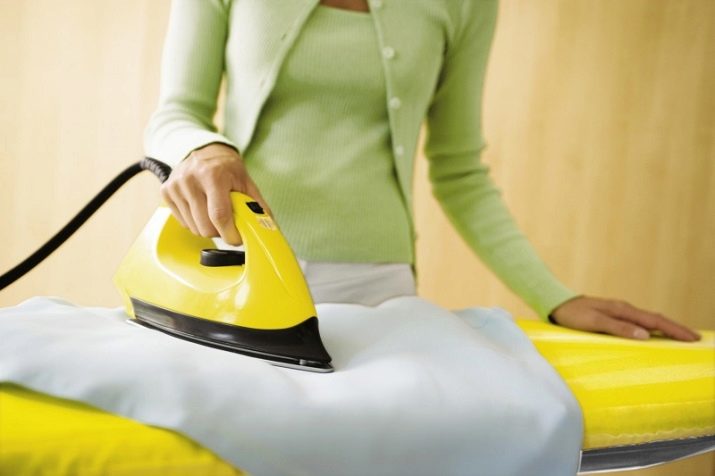
Cleaning rules
First, determine the type of dirt on the iron. It can be rust, deposits or carbon deposits. Check the outsole carefully for scratches. Please note that not everything can be seen with the naked eye.
It is also important to take into account the material of the soleplate of the iron, the cleaning process itself depends on it. All these nuances are important, but there are general rules for cleaning the iron:
- It is strictly forbidden to use hard sponges and brushes. Do not try to mechanically remove carbon deposits. Do not use highly abrasive powders to clean the soleplate. Failure to do so will result in scratches.
- Small scratches on the soleplate of the iron must be removed with a mixture of paraffin and salt. Mix the ingredients in equal proportions and pour the mixture onto a piece of paper. Cover the paraffin with a napkin. Heat your iron to high and iron this napkin thoroughly. This will make your iron smooth again.
- To clean the soles, you can only use products that chemically react with dirt. This will ensure that there is no mechanical stress.
- Handle the device only after disconnecting it from the mains.
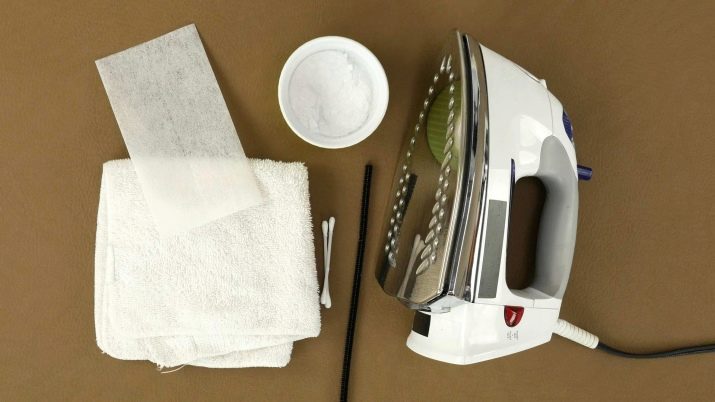
Funds
For cleansing, you can choose folk remedies or special store-bought ones. It all depends on your preference. Popular and effective cleaning products:
- Special pencil. A heated (disconnected from the power supply) iron must be quickly rubbed with a pencil. This must be done carefully: do not press on the pencil, do not touch the sole with your hands, wear protective gloves on your hands. After the carbon deposits have dissolved, run the iron over the cotton fabric.
When buying a pencil, pay attention to the instructions, which indicate the type of sole for which you can use the crayon.
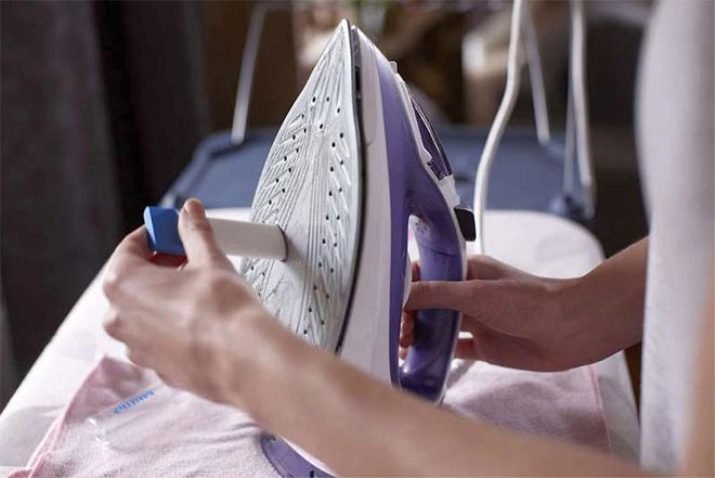
- Vinegar. It is easy to remove fresh carbon deposits with vinegar. Prepare a mixture - 250 ml of water and 2 tbsp. l. vinegar. Soak a cotton cloth or cotton ball in the solution and wipe down the warm soleplate.

- Ammonia. The substance is used in several variations. You can mix ammonia and vinegar in equal proportions, or add a couple of drops of the product to the juice from one lemon. Sometimes ammonia is used in its pure form. In one of the solutions, you need to moisten a cotton cloth and wipe the slightly heated sole. In case of heavy carbon deposits, place the iron on a soaked cloth and leave overnight.
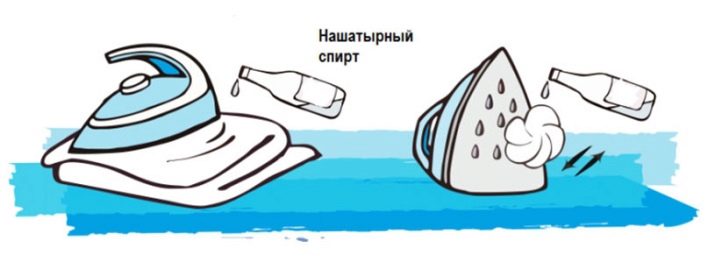
- Hydrogen peroxide... This tool is especially popular. The liquid substance can also be replaced with hydroperite tablets. The solution is applied in the same way as the previous ones. Wipe the sole of the soles with the dampened gauze and iron the cotton piece of fabric.
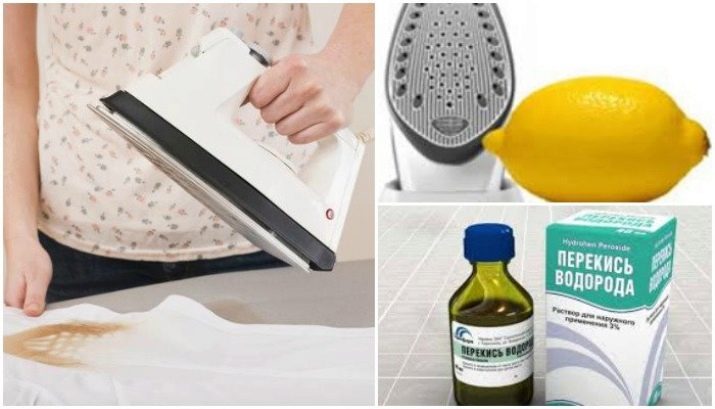
- Toothpaste. Try to deal with the dirt with toothpaste. Apply the product to a heated iron with an old toothbrush. It is better to cover the entire surface, otherwise fine carbon deposits can be skipped. Next, leave the appliance on for 30 minutes. Soak a napkin in warm water and remove the toothpaste from the surface of the iron soleplate.

- You can always wipe off the burn with regular soda. Simply put a small amount of powder into cheesecloth and rub the hot surface of the iron. If you understand that radical methods are needed, try cleaning with Shumanite. It should be used according to the instructions.

How to scrub your iron correctly?
At home, you can easily clean the platform of even a very old iron. Prepare the surface and additional materials for proper cleaning. Find a quiet place at home where children and pets will not disturb you. There should be a socket, a flat surface and a cotton cloth nearby.
Cleaning the bottom of the iron is much easier if you start the procedure right away. A burnt-out appliance should be treated with the chosen product, observing safety rules. Be sure to protect yourself and family members from possible burns.
You can get rid of burnt fabric and black plaque from plastic using ordinary foil. This method is not known to everyone, but it is very effective. A sheet of foil should be laid out on an ironing board and ironed with a hot iron. After the procedure, it is necessary to wipe the surface with a cotton cloth.
With the help of foil, you can clean the trail from synthetic clothing and even wool.

A hole iron requires extra care when cleaning. If you are using paraffin wax or a special pencil for cleaning, then the holes need to be cleaned with cotton swabs. Also, do not forget to run steam through them to remove those products that have gotten deep inside. If this is not done, then greasy marks will remain on all clothes.
You can get rid of old fumes and blackness with the help of a special iron bath. An old baking sheet is often used for this. Pour 2 cm of hot water into it and add a suitable cleaning agent. Also, classic laundry soap will help get rid of the burn. Just rub the iron, wait until dry and remove with a wet cloth.
You need to clean the iron not only from the outside, but also from the inside. To do this, use only distilled water, a regular tap will only aggravate the situation.
Check the steam iron for limescale deposits after each use.
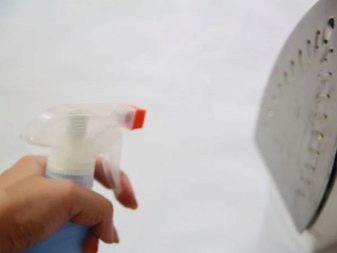
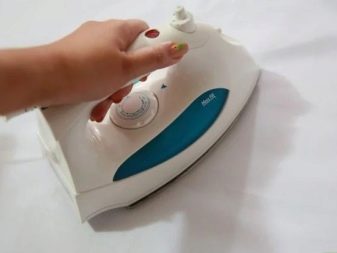
Features of cleaning coatings
If you want to clean the sole of the iron properly, consider its material. With the wrong approach, there is a risk of completely ruining the electrical appliance. Modern irons come with teflon, stainless steel, aluminum, ceramic and cermet soles:
- Appliance with non-stick teflon coating will upset you with carbon deposits only through your fault. The only reason is the wrong ironing temperature. Such contamination can be easily removed using conventional cleaning agents. You can use a pencil, acetic acid, citric acid, peroxide, or acetone-based liquids. Teflon does not tolerate powders and soda, salt. Because of them, scratches invisible to the eye may appear on the coating. Damaged coating slips worse.
- The next most popular is ceramics. These soles are reliable and durable. The ceramic sole is excellent at keeping the temperature. Cleaning a ceramic coated appliance at home is not easy. Ceramics are especially sensitive to mechanical stress and require special care. Many ceramic coated models are self-cleaning, but limescale deposits can interfere with this function. When cleaning the sole, only liquid products can be used. In the fight against carbon deposits, lime and scale, lemon juice, ammonia and ordinary peroxide will become your allies.
- Appliances with soles stainless steel and aluminum are less popular. As a rule, these are old irons that have been serving for a very long time. These materials are prone to carbon deposits. Cleaning these irons is not very different from previous options. It is important to know that aluminum cannot be cleaned with acids. Otherwise, corrosion and dark spots may appear on the surface, it may deform. Such a sole will completely ruin your clothes when ironing.
- Main advantage metal sole - the possibility of using abrasive substances. Aluminum and stainless steel are absolutely not afraid of mechanical damage. It is very easy to clean off fresh dirt, even with an ordinary kitchen knife.
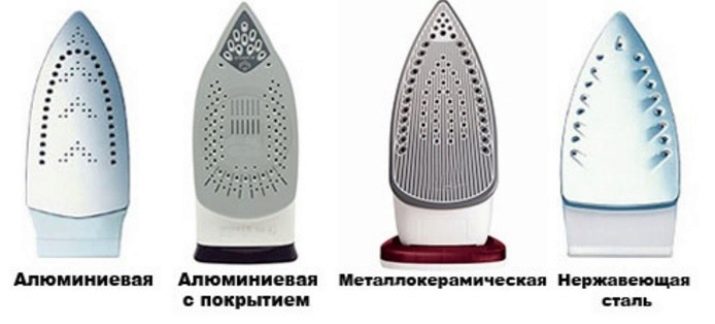
How to wash the inside?
An iron with a steamer requires close attention, often look into the water tank. All kinds of contamination can appear there, including green plaque, mold and rust marks. To avoid severe contamination, use filtered drinking water or distilled water for your iron.
If limescale deposits appear inside the water tank, you will immediately notice it. When ironing, dampening or steaming, your items will start to become covered with yellowish spots.
It is extremely difficult to wash off such dirt, some things deteriorate irretrievably.

Many modern irons are self-cleaning. You can use this property like this:
- Pour purified liquid into the water tank.
- Turn on the iron at maximum power, wait until the soleplate has completely warmed up.
- After about 5 minutes, completely turn off the appliance and press the special button that activates cleaning.
- You will see the steamer turn on. Steam will escape from the holes along with dissolved contaminants. It is better to carry out this manipulation over the basin.
- For better cleaning, lightly shake the appliance and wipe with a cotton cloth.
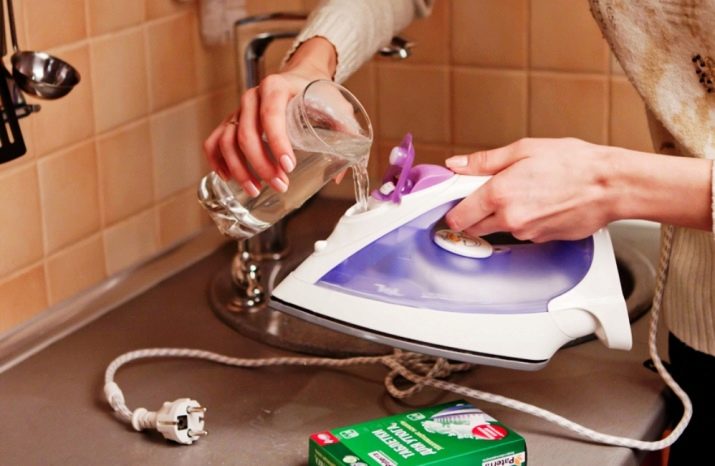
Sometimes there is such serious pollution that self-cleaning is powerless. In this case, you will have to switch to more aggressive methods. The iron with a steamer can be washed with the help of such folk remedies:
- Lemon acid... You will need 25 g of the substance and a glass of water. Dissolve the powder and pour inside the device. Heat the iron to maximum power and disconnect from the power supply. Hold the appliance over a convenient water tank, turn on the steam function. This will cause scale flakes to come out of the reservoir and the soleplate openings. After cleaning, be sure to rinse the iron with plain water and wipe the soleplate with a tissue.
- Water with gas. The cleaning principle is similar to the previous one. Instead of a mixture with citric acid, you need to pour carbonated water into the tank. Such water contains substances that are capable of dissolving scale.
- A vinegar solution. Mix equal proportions of water and vinegar and pour the resulting liquid into 2/3 of the container. Place the iron in an upright position and preheat to maximum temperature. Leave the device alone for 5-10 minutes. During this time, the device will be randomly turned off and on again, do not interfere with this.

Now hold the appliance horizontally over a basin or sink and turn on the steam function. Keep the device at a distance so as not to inhale the vapors of the vinegar and dissolved dirt. To remove the vinegar, pour plain distilled water into the tank and repeat the procedure.
There are special industrial substances on the market for cleaning the iron reservoir from various types of contaminants. Quite an effective remedy - "Anti-scale"... You will need ½ tbsp. l. funds for a glass of water. The solution is poured into the reservoir and the iron is heated to maximum. Then the iron must cool down, and the tank must be freed from the mixture and rinsed with clean water.

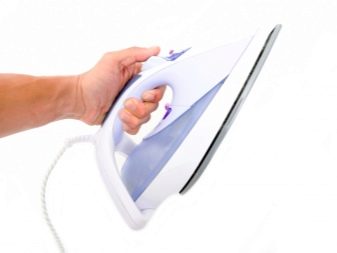
Remove rust stains and limescale with Cillit. Place the iron with the soleplate facing up and preheat. Using a syringe or pipette, add the product to the steam holes and let it brew. After 7-10 minutes, dirt will ooze from the holes, wipe it off with a damp cotton cloth. Rinse the inside of the iron with purified water.
All industrial products contain acids. You need to work with them strictly according to the instructions. The very principle of use is no different from the use of folk remedies.
You should also prepare the solution and pour it into the reservoir of the heated household appliance. The dirt itself comes out thanks to the steam.
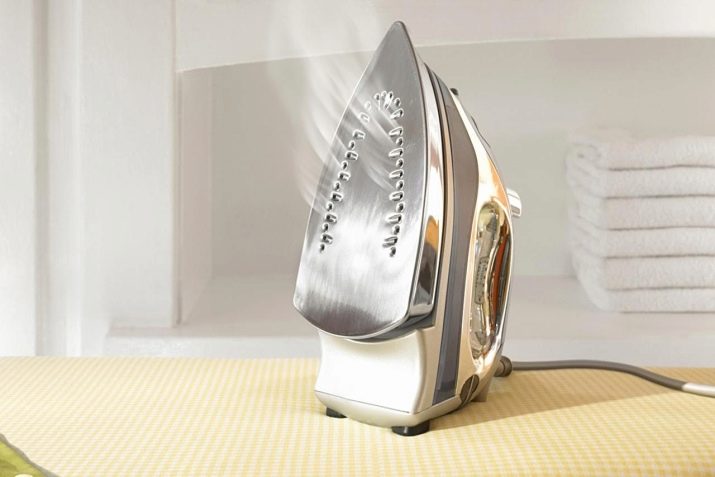
Prevention of contamination
It is important to know effective methods of dealing with iron contamination, it is equally important to know about the prevention of their occurrence. Experts give the following recommendations:
- Be sure to read the instructions for your iron. Manufacturers describe in detail the rules of operation, do not neglect them.
- Use only purified water for ironing. Plain tap water is too contaminated with salts and other heavy elements. All of these lead to serious contamination of the tank and steam vents.
- The sole of the iron should be wiped with a damp cotton cloth after each use.
- Do not leave the iron with water in the tank. It is such a rash act that can lead to the formation of plaque inside the tank.
- Your inattention when setting the temperature can lead to the appearance of carbon deposits. To avoid such a nuisance, do not remove labels from clothing and follow the recommendations indicated by the manufacturer.Be especially careful with synthetic fabrics and wool, as they can seriously burn to the sole of the appliance.
- Delicate fabrics should be ironed through damp gauze. Use a cotton cloth when ironing the wool. It is recommended to steam silk clothes without touching the fabric with the sole itself.
- Modern irons cannot be cleaned with steel wool, coarse brushes or abrasive powders. This incorrect approach to the cleaning procedure will lead to scratches. Mechanical damage worsens the sliding of the iron, complicates the ironing process. Moreover, such an iron can completely ruin your clothes.
For more information on how to clean your iron, see the next video.








